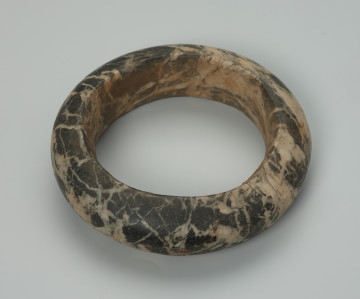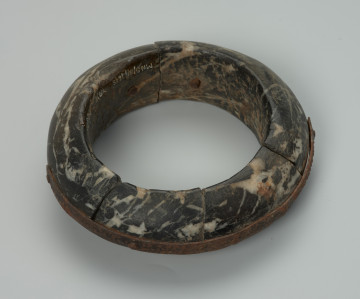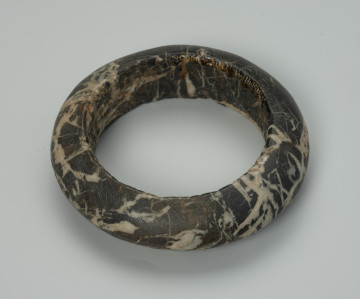
Men's bracelet
między 1930 — 1940
National Museum in Szczecin
Part of the collection: Collection of Dogonian art
The Dogon men wore the bracelet on the forearm. Its outer surface was smoothed, while the inner surface was left rough not to slip from the hand. After it broke in two, it was repaired by a Dogon blacksmith who joined the two pieces together with small and narrow strips of metal sheet. The repair was not done very carefully. The Tuareg, a pastoral people inhabiting the Sahara and the borderlands of the Sahel (Algeria, Libya, Niger, Mali, Burkina Faso), specialise in producing this type of stone bracelet. They cut them from solid stone and turn them using a simple lathe. Short incisions can be seen on the inside of the bracelet, possibly the remains of a signature, because some Tuareg bracelets had inscriptions in the Tifinagh language. Bracelets of this type served the Tuaregs as weapons. During war fights, they were used to put pressure on the enemy's neck.The Dogon have always feared the so-called 'people of war' to which they counted the Tuaregs among others, especially slavery. Slaves were captured not only during battles, the danger of losing their freedom also threatened the moment they left the village. Conflicts and attacks were also why the Dogon migrated from their ancestral homeland - the Mande country. Archival written sources confirm that. At the beginning of the 20th century, the official colonial Fawtier noted that 'the Habe (Dogon) came from Manding, which they left about 450 years ago to escape the plundering that ravaged the country'. The Dogon, in search of a new homeland, went to what is now the Bandiagara massif, where they settled. Today, they find themselves in an equally difficult and complex geopolitical situation. Their country is on the brink of conflict between the government of the Republic of Mali and the Tuareg rebels and Islamic fundamentalists from the north of the country.
Katarzyna Findlik-Gawron
Author / creator
Dimensions
cały obiekt: height: 3,4 cm
Object type
body adornment, jewellery
Creation time / dating
Creation / finding place
Identification number
Location / status

między 1930 — 1940
National Museum in Szczecin

między 1930 — 1940
National Museum in Szczecin

między 1930 — 1940
National Museum in Szczecin
DISCOVER this TOPIC
National Museum in Lublin
DISCOVER this PATH
Educational path